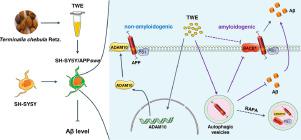Phytomedicine ( IF 6.7 ) Pub Date : 2022-06-06 , DOI: 10.1016/j.phymed.2022.154245 Longhe Zhao 1 , Zhaorong Yue 1 , Yanni Wang 1 , Jiatao Wang 1 , Inam Ullah 2 , Fahim Muhammad 2 , Yongtao Zhou 3 , Hongmei Zhu 1 , Xin Wang 1 , Hongyu Li 4

|
Background
Alzheimer's disease (AD) is the most common neurodegenerative disease. Deposition of amyloid β plaques (Aβ) is a central hallmark of AD. Accumulating evidence suggest that shifting amyloid precursor protein (APP) metabolism pathway to non-amyloidogenic ways and inducing autophagy play key roles in AD pathology. In published reports, there is no research on the APP metabolic process of Terminalia chebula Retz. (T. Chebula).
Purpose
The study aims to assess the effects of T. Chebula in AD transgenic SH-SY5Y cells to determine its underlying mechanisms on reducing Aβ level by regulating APP metabolic process.
Methods
The effects of T. Chebula water extract (TWE) on APPswe transgenic SH-SY5Y cells were analyzed by cell viability. ELISA used to quantify extracellular Aβ1–40 and Aβ1–42 generations. Western blot and RT-PCR assays were chosen to detect the expression of proteins and genes. The acridine orange (AO) stain was used to label autophagic-vesicles.
Results
Treatment with TWE significantly suppressed the Aβ1–40 and Aβ1–42 generations of APPswe transgenic cells. TWE inhibited amyloidogenic pathway by reducing BACE1 expression, and promote non-amyloidogenic pathway by inducing ADAM10 level of APP metabolism. Additionally, TWE induced autophagy in APPswe transgenic cells involved in APP metabolism to shift the balance to non-amyloidogenic pathway.
Conclusion
In summary, our finding first time expounded that TWE can inhibit the generation of Aβ1–40 and Aβ1–42 in APPswe transgenic SH-SY5Y cells, which were regulated APP metabolism tends to non-amyloid metabolism pathway and mediated by autophagy. The results presented a novel finding for AD treatment of traditional natural medicines.
中文翻译:

Terminalia chebula Retz 激活自噬。通过将 APP 加工转向 APPswe 转基因 SH-SY5Y 细胞中的非淀粉样蛋白生成途径来减少 Aβ 的产生
背景
阿尔茨海默病 (AD) 是最常见的神经退行性疾病。淀粉样蛋白 β 斑块 (Aβ) 的沉积是 AD 的中心标志。越来越多的证据表明,将淀粉样前体蛋白 (APP) 代谢途径转变为非淀粉样蛋白生成方式并诱导自噬在 AD 病理学中起关键作用。在已发表的报道中,没有关于榄仁的 APP 代谢过程的研究。( T. Chebula )。
目的
本研究旨在评估T. Chebula在 AD 转基因 SH-SY5Y 细胞中的作用,以确定其通过调节 APP 代谢过程降低 Aβ 水平的潜在机制。
方法
通过细胞活力分析T. Chebula水提取物 (TWE) 对 APP swe转基因 SH-SY5Y 细胞的影响。ELISA 用于量化细胞外 Aβ 1-40和 Aβ 1-42代。选择蛋白质印迹和 RT-PCR 测定来检测蛋白质和基因的表达。吖啶橙 (AO) 染色剂用于标记自噬囊泡。
结果
用 TWE 处理显着抑制了APP swe转基因细胞的 Aβ 1-40和 Aβ 1-42代。TWE 通过降低 BACE1 表达抑制淀粉样蛋白生成途径,并通过诱导 ADAM10 水平的 APP 代谢促进非淀粉样蛋白生成途径。此外,TWE 在参与 APP 代谢的 APP swe转基因细胞中诱导自噬,从而将平衡转移到非淀粉样蛋白生成途径。
结论
综上所述,我们的发现首次阐明了TWE可以抑制APP swe转基因SH-SY5Y细胞中Aβ1-40和Aβ1-42的产生,这些受调控的APP代谢倾向于非淀粉样蛋白代谢途径,并由自噬介导。该结果为传统天然药物治疗 AD 提供了新发现。











































 京公网安备 11010802027423号
京公网安备 11010802027423号